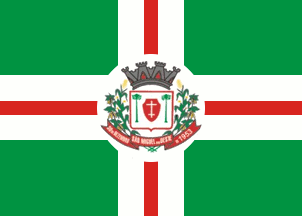 image by Dirk Schönberger,
12 August 2012
image by Dirk Schönberger,
12 August 2012
Last modified: 2021-12-11 by ian macdonald
Keywords: santa catarina | são miguel do oeste |
Links: FOTW homepage |
search |
disclaimer and copyright |
write us |
mirrors
 image by Dirk Schönberger,
12 August 2012
image by Dirk Schönberger,
12 August 2012
The municipality of São Miguel do Oeste (39,390 inhabitants in 2016; 23,440 ha) is located 650 km west of Florianópolis.
Ivan Sache, 7 November 2021
An upright white cross with a narrow central red stripe on a green field, with the municipal shield in the centre on a white disk.
Official website at
http://www.saomiguel.sc.gov.br
Dirk Schönberger,
12 August 2012
The flag and arms of São Miguel do Oeste are prescribed by Municipal Law No.
1,005 promulgated on 20 April 1976.
Article 6.
The municipal flag of
São Miguel do Oeste, designed by heraldist Arcinoé Antonio Peixote de Faria,
shall be: "Quartered by a cross, the green quarters formed by white stripes of
2 units in width superimposed with red stripes of 1 unit in width, placed in
the vertical and horizontal dimensions 6 units from the hoist and charged with
a white circle of 8 units in circumference inscribing the municipal coat of
arms".
§1. In compliance with the tradition of Portuguese heraldry, of
which Brazil inherited the norms and rules, the municipal flags have to be
divided in eight, six, four or three parts, using the same colors as in the
coat of arms and featuring in the center or at hoist a geometric figure
inscribing the municipal coat of arms.
§2. The municipal flag of São
Lourenço do Oeste is compliant with this general rule, being quartered by a
cross recalling the people's Christian spirit. The coat of arms featured on the
flag represents the municipal government while the white circle inscribing it
represents the town proper, as the seat of the municipality. The circle is the
heraldic symbol of eternity as a geometric figure without either a beginning or
an end. White is a symbol of peace, friendship, work and prosperity.
The
white stripes charged with red stripes quartering the flag represent the
municipal power spreading over all the quarters of the territory. Red is a
symbol of dedication, self-esteem, audacity, intrepidity, and courage. The
green quarters represent the rural estates scattered over the municipal
territory. Green is a symbol of honor, civility, courtesy, glee and abundance;
it is also the symbol of hope, which is green since greening fields in spring
promise profuse harvests.
Article 7.
In compliance with heraldic
rules, the municipal flag shall have the official dimensions prescribed for the
national flag, 14 units in width on 20 units in length.
Article 19.
The coat of arms of São Miguel do Oeste, designed by heraldist Arcinoe Peixoto
de Farias, is described in proper heraldic language as follows:
Samnite
shield surmounted by a six-towered mural crown argent ports gules. On a field
argent, a Swiss-styled escutcheon gules charged with an episcopal Cross of
Lorraine argent surrounded by stylized Brazilian pines vert. [The shield
supported by] maize and soybean plants proper interlaced in base supporting a
scroll gules inscribed in letters argent the toponym "São Miguel do Oeste"
surrounded by date "30 de dezembro de 1953".
The coat of arms shall have
the following symbolic interpretation
a) The Samnite shield used to
represent the arms of São Miguel do Oeste was the first style of shield
introduced to Portugal by French influence; inherited by Brazilian heraldry, it
evokes the colonizing race and main builder of the nation.
b) The mural
crown surmounting the shield is the universal symbol of domains' coats of arms;
argent (silver) with six towers, only four of them visible in perspective, it
classifies a town of third rank or municipal seat.
c) Argent (white) is a
symbol of peace, friendship, work, prosperity, purity and religious feelings.
d) The Swiss-styled escutcheon gules (red) charged with an Episcopal Cross of
Lorraine argent is the symbol of São Miguel do Oeste, the Archangel patron
saint and namesake of the municipality.
e) Gules (red) is the heraldic
symbol of dedication, patriotic love, audacity, intrepidity, courage and
valiance.
f) The stylized Brazilian pines vert (green) represents the native
resources of South Brazil, pine timber extraction being the landmark of the
colonization of Santa Catarina Far West and originating in population nucleus
that grew up to towns, as it was the case for São Miguel do Oeste.
g) Green
is a symbol of honor, civility, courtesy, glee and abundance; it is also the
symbol of hope, which is green since greening fields in spring promise profuse
harvests.
h) As supporters, the soybean and maize plants represent the main
crop produced by the generous and fertile soil, the municipality's main source
of income.
i) The scroll gules (red) is inscribed the toponym "São Miguel
d`Oeste" surrounded by the date of political emancipation.
https://leismunicipais.com.br/a/sc/s/sao-miguel-do-oeste/lei-ordinaria/1976/101/1005/lei-ordinaria-n-1005-1976-dispoe-sobre-a-forma-e-apresentacao-dos-simbolos-do-municipio-de-sao-miguel-do-oeste-e-contem-outras-providencias?q=brasão
Leis Municipais database
Photo
https://www.facebook.com/PrefeituraSaoMiguel/photos/6618682888157816
Ivan Sache, 7 November 2021